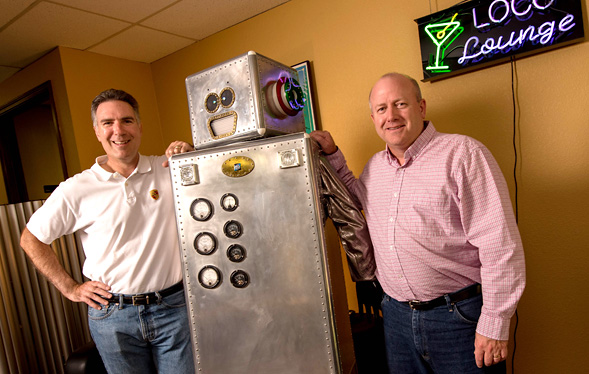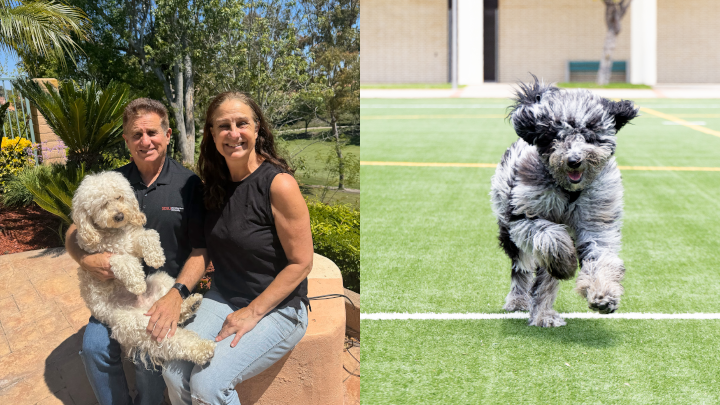Serious Fun
Alumni Brad Hoffert and Steve Kelsey teamed up to create LocoLabs, an engineering design firm with a sense of humor and purpose.

An abridged version of this story appears in the summer issue of 360: The Magazine of San Diego State University.
As students at San Diego State University, Brad Hoffert and Steve Kelsey vowed they would start a company together one day. Since these two are anything but conventional engineers, their venture, LocoLabs, is not your typical engineering development and design firm.
The first clue is the robot in the lobby of their Santa Clara offices. An employee created it — from the tennis shoes on up — for one of LocoLabs’ legendary Halloween parties. Then there are the products Hoffert and Kelsey have helped to develop. They range from a 3D-imaging, gamma-ray detection instrument for the Department of Defense (DOD) to a games console platform for children and a DVD rental kiosk.
LocoLabs collaborates with inventors to turn original ideas into reality by engineering Cinderella prototypes into elegant, marketable products. Before joining forces, Hoffert worked for Sun Microsystems and Kelsey was with Qualcomm Inc. Each pledged $3,000 to start up LocoLabs in 1996 and “never had to put in another dime,” Hoffert said. Here, they answer questions for 360: The Magazine of San Diego State University.
Both of you have multiple degrees. In your field, how important is it to have a broad domain of knowledge?
BH It’s a combination of staying curious and acting on your curiosity. That's what prompted me to double major in electrical engineering and German with a minor in computer science. The goal of starting my own company was largely driven by my desire to always be doing new things. The Steve Buscemi character in “Armageddon” sums it up for me when talks about why he likes his job. “Because the money's good, the scenery changes and they let me use explosives, okay?” It’s sort of like that, but without the explosives.
Part of my role is to quickly build trust with customers, to make them comfortable that we can take on a wide variety of projects and do a great job. Having a broad background is critical to that. We are what is called a “systems house,” meaning we deliver hardware, software and mechanical solutions, integrated together. Most of our engineers are cross-trained in hardware and software. So the person doing hardware knows what the software person needs and wants, and vice versa. From the start, this co-design process results in a high level of elegance and efficiency. And most of us are nature lovers, hikers, athletes… there are quite a few musicians on the team, too. Those personal interests also drive our technical knowledge and passions. We’re consumers who want new features and more intelligent design, and we’re engineers who can deliver those things.
Talk about the project you’re doing for DOD. How did that come about?
SK We were on a High Sierra hiking trip in Yosemite and met an interesting gentleman at one of the camps. We chatted for some time and exchanged business cards. A couple of years go by and, boom, we get an email from him. He works for a large firm on the East Coast that specializes in government contracting. A bunch of paperwork later, we’re working together on a very advanced 3D-imaging gamma-ray detecting instrument. Now, we’re at work on the third generation of the system, having turned a cool lab-bench science project into a useable instrument. You never know where a chance meeting or random connection—or a hike in the high country—might lead.
What is the most fun project you've tackled together?
BH Bubble is a children’s game console for young children that uses interactive features of DVDs for entertainment and learning. It started with a referral from a company run by a German entrepreneur we know. During an initial phone conversation with one of the Bubble founders on a Thursday, the technical solution to their design challenge came into my head instantly. We scheduled a meeting for the following Monday, to further explore their goals and challenges and help these British entrepreneurs determine whether they wanted to engage with us on the project. Behind the scenes, the LocoLabs team jumped in, overnighted chips, machined enclosures, wired up boards, wrote a ton of software and cranked the entire weekend. In three days, we put together a prototype of the product solution I’d envisioned.
The customer showed up on Monday to explain the problem in more detail, and I whipped out the prototype from under the table and proceeded to demonstrate the solution. He hired us on the spot. That prototype allowed them to hit the financing goal and raise millions of dollars and take the company public. We moved on to designing software and hardware and built more than 100,000 consoles. We followed this with a cost-reduced version, building a custom ASIC to integrate the digital and analog features into one chip. Of course, we’re thrilled that this product was named a “Dream Toy” by the Toy Retailer Association, but the key factor that makes projects fun is the people. At the end of the day, life is short and you have to enjoy what you are doing. Working with this pub-crawling British company, with their passion for technology and clever sense of humor, was a joy.
In today’s market, what separates a great idea from a good idea?
BH I believe there are two types of great ideas—those whose time has come, and those whose time will come. We listen for the sucking sound of the market pulling the product. We actually look for projects to invest in where an early prototype has already been built, customers are clamoring for it, but the product is way too premature. We have jumped in on multiple occasions to harden and properly release a product to make it a success. Redbox is a good example. We were asked to look at why the first generation was unreliable. We ended up using one of our own modules to work around the technical constraint, and ultimately built multiple generations of DVD rental machines for DVDPlay, which was later subsumed by Redbox. The CEO of DVDPlay is a dear friend and backpacking companion with a common German background; many technical or strategic conundrums have been solved over a pint and a few pretzels. Steve’s skateboarding history melded well with the technical challenges of a surfer-camera project for some crazy smart guys with a kite-boarding school in the Bahamas, especially when we called on Steve to skateboard around the parking lot to tune the GPS tracking algorithms.
SK There are many great ideas out there, and even more good ideas. What separates any idea from a great product is a sound plan, inspired marketing and well-engineered implementation. Marketability is pretty much a requirement for success. Sometimes the consumers don’t know they need the product until you create it. Those are the trickiest products to develop, but the most rewarding, when you guess correctly, and the marketing team is equally inspired. Our work on the original TiVo design is a great example of this.
What are your best memories of SDSU?
SK There are so many. Skateboarding all over campus and getting my photo in the Daily Aztec by jumping off the “Free Air” wall of Aztec Center. Meeting my wife (to-be) in Philosophy 101 and getting married while still in school. Learning from some great professors in some memorable classes. Destroying a few curves. Conquering some challenging projects, often way beyond the required scope. Performing with friends in the Marching Aztecs and hanging out at the Murph so many Saturday nights. Being a rare electrical engineering/computer science double major. Working with and for various professors and departments at SDSU. Teaching a couple of computer design courses at SDSU for a professor friend on sabbatical.
BH Sitting in the banana garden taking a nap in the warm afternoon shade. Having my Physics 195 professor try (unsuccessfully) to convince me to switch to his department. Learning machine languages from Vernor Vinge (and later reading his science fiction series). Putting Fortran punch cards into the old engineering IBM. Doing my senior project under Dr. Len Marino’s watchful eye. (Later, in our earliest partnership agreement, he agreed to be the arbiter in case Steve and I ever disagreed on anything major. We’ve never had to call him, but thanks, Len!) Meeting my business partner and lifelong friend, Steve, and pledging to him that we would start a company some day. Meeting my spikey- haired, quirky, future wife and traveling the world with her through the CSU study abroad program.
What are the most important qualities to look for in an engineering college?
BH Make sure they let you play with explosives. Senior projects and the capstone courses are the best way to really know if you have what it will take to be great engineer. I think the depth and breadth of SDSU’s engineering program is a key consideration. You want to be where there are lots of options. You don’t know what will pique your interest as you move from lower division courses to upper division. Having a lot of variety is key to finding something you love to do. The study abroad programs in the CSU system are also top rate. Take advantage of them. I met my brilliant and fun-loving wife 30 years ago on the CSU Learn German in Germany program. She was from Sac State; now she runs finance and HR for our company. Our son graduated from SDSU’s School of Theatre, Television and Film. Don’t forget the campus atmosphere; SDSU has a unique blend of fun-spirited energy and serious passion. That unique combination helps inspire and drive you. For many years, I have been an active member of the advisory committee for the Department of Electrical and Computer Engineering. SDSU is a great institution and I’m proud to be asked to participate. I love to see the passion of the faculty to find creative ways to inspire learning.
SK In my book, it’s all about the people doing the teaching and the quality and relevance of the content. Access to good labs, proper equipment and materials is also important. Add to that relevant work opportunities in the surrounding communities and you have a great package. Once at your school of choice, my best advice is to research the courses and professors and fight to get the ones you really want. Then kick it into high gear, learn all you can, go beyond the requirements and conquer something hard, develop something cool.



